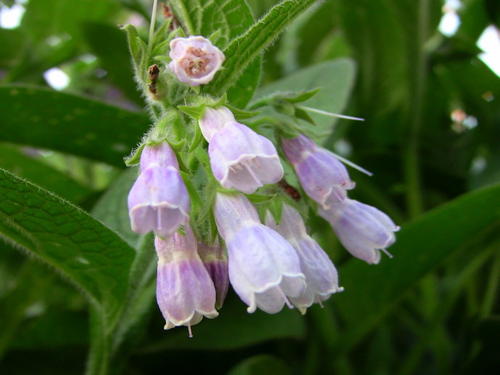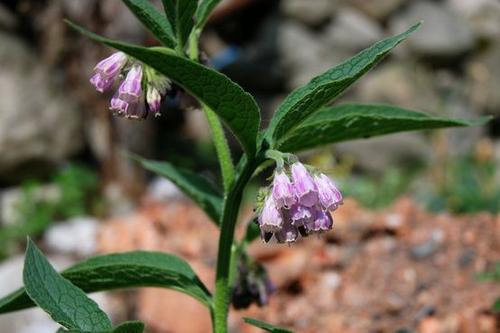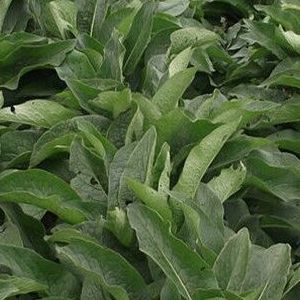Comfrey (Symphytum officinale) profile
Written by Maggie
Mar 10 2021

Comfrey (Symphytum officinale L) is a fascicular perennial herb, 30-90 cm tall, whole plant covered with downward slightly curved bristles and short depose hairs. Comfrey is a typical mesophyte in the mountain forest area. Native to the European part of the Soviet Union and the Caucasus, it was introduced and cultivated in 1973 as a precious gift from North Korea to China. Comfrey has wide adaptability, high yield, long utilization period and good palatability. It is a high quality and high yield livestock and poultry feed crop. Comfrey also has high nutritional value, can be used as medicine and has some ornamental value.
Comfrey picture

Morphological characteristics of Comfrey
Rhizome
Comfrey is a tufted perennial herb, 30 -- 90 cm tall, covered with downward-curving bristles and short spreading hairs. Roots are developed, taproot stout, light purple brown. Stem several, erect or oblique ascending, branched.
Leaf
Basal leaves of Comfrey are usually 50-80, up to 200, long stiolate, leaves lanceolate, ovate-lanceolate to ovate, 30-60 x 10-20 cm long, slightly fleshy, apex acuminate; Stem middle and upper leaves are smaller, sessile, base decurrent.
Flowers
The inflorescence of Comfrey consists of many flowers; Calyx lobed to near base, lobes lanceolate, apex acuminate; Corolla is 14 -- 15 mm long, lavender to purplish to yellow-white, lobes triangular, apex extruded, laryngeal appendages lanceolate, ca. 4 mm long, not protruding from corolla eaves; Anthers ca. are 3.5 mm long, with a slightly protruding septum at the apex, filaments ca. 3 mm long, proximally nearly as wide as anthers; Ovary is usually sterile, occasionally 1 nutlet matured in individual flowers.
Fruit
Comfrey's nutlets are lopidly ovate, 3-4 mm long, black, smooth and glossy.
The ecological habits of Comfrey
Comfrey is a typical mesophyte of mountain forests. Suitable for a wide area, Comfrey is cold and high temperature resistant, not limited by the region; There are no strict requirements for soil. Except for saline alkali land, thin ridges and low-lying land with poor drainage, general land can be planted. Large scale farms can be located in large areas of farmland or barren hills.
How to grow and care for Comfrey
The temperature
The growth rate of Comfrey was the fastest at 22℃~28℃, the growth rate was slow when the temperature was below 7℃ in autumn and winter, the growth stopped when the temperature was below 0℃, and the germination began at 0℃~7℃ in early spring.
Light
Comfrey is a combination of sun and shade tolerant, requiring a good amount of light during vegetative growth, but is also tolerant of shade and will grow well if planted in orchards or under trees.
Moisture
Comfrey is sensitive to water, and the seedling suddenly wilts when it is dug out of the land, and is fresh when watered. When the soil water holding capacity decreased to 30%, the growth was slow and withering occurred.But overnight, especially after a long drought and rain, the forks can grow again; When the temperature is above 20℃ and the soil water holding capacity is 70%~ 8O %, the growth rate is the fastest, with an average daily increase of 2-3cm.
Hoe weeding
The first intertillage weeding was carried out after colonization, and the second and third intertillage weeding and earthing were carried out before sealing row or ridge. After each harvest combined with fertilization for a medium tillage weeding, so that the soil loose, maintain soil moisture, improve soil ventilation conditions, for regeneration.
Fertilizer irrigation
Comfrey plants, with large, dense leaves, grow rapidly, harvest more often, yield more, and require more fertilizer than other plants. After transplanting and every year before turning green to top fertilizer 1 times. After each harvest, combined with medium tillage weeding and topdressing 1 time of quick nitrogen fertilizer, ammonium sulfate 10~15 kg or decomposed feces and urine 750~1000 kg per 667 square meters. Top dressing should be applied next to the plant, not on the leaves or roots.In dry season, water should be irrigated once after each harvest and top dressing. Should not flood irrigation, can be poured after furrow irrigation to prevent rot root dead plant. Ditches should be opened for drainage in rainy seasons.

Disease control of Comfrey
Disease control
Comfrey is prone to brown spots and blight in high temperature and humidity. Plant diseases should be exhumed early and burned or buried deep, while soil should be sprayed with 500 times 80% carbendazim solution or 800 times 80% mancozeb solution and neighboring plants should be sprayed.
Pest control
In the seedling stage of Comfrey, there are underground pests such as ground worms and grubs, and roots can be filled with 90% trichlorfon 1000-1500 times liquid. The growth period mainly has the yellow stripe jump armour to harm. At the time of occurrence, a 1:400-fold disulfide emulsion was mixed with a 1:1500-fold DDVP spray. If mealworms suck leaf juice, they can be sprayed with 3% chloro-imidacloprid 600~700 times liquid for insect control.
Comfrey's area of distribution
Comfrey is native to the European part of the Soviet Union and the Caucasus.
Comfrey is also distributed in Jiangsu, Fujian, Hubei and Sichuan provinces in China.
Comfrey uses
Forage value
Comfrey harvested is directly fed by cutting or mixed with other dry fodder. If the conditions can be beaten into pulp or into grass mud mixed with feed feed.Its branches and leaves are tender and juicy, with aromatic smell and soft texture. Grass after cutting or pulping exhales a light cucumber fragrance. Pigs, cattle, sheep, rabbits, chickens, ducks, geese, ostriches and herbivorous fish all like to eat Comfrey, and can significantly promote the growth and development of livestock and poultry. Rich in protein and vitamins, high nutritional value, the content of various nutrients and their digestibility are higher than the general forage. Comfrey can be fed green or silage or made into a thousand grass meal, and is best fed in a green state. The dry matter of fresh grass at flowering stage contains 24.3% crude protein, 5.9% crude fat and 10.1% crude fiber. Comfrey can also be mixed with grasses such as corn, barley and oats for silage at the flowering stage. After summer and autumn harvest, it can be directly made into dry leather, and hay powder can be made into hay powder after grinding. The hay powder can be used as a supplementary source of protein, high mineral content and multi-dimensional nutrition for livestock and poultry.
Medicinal value
Comfrey contains allantoin, which stimulates new cell growth and is used topically to treat wounds and promote healing. Medicinal rhizome, still have the function of activating blood and cooling blood, clearing heat and detoxification.
In addition, because it contains a lot of allantoin and vitamin B12, Comfrey can prevent and treat livestock and poultry enteritis.
The garden use of Comfrey
Three horticultural varieties of the Comfrey species are now in cultivation in China, where many variations have been produced.
Comfrey flowers vary in color from lavender to yellowish to yellowish white from the base to the petals. When in full bloom, they are gorgeous and beautiful. Comfrey can be used as garden plants, ground cover plants and potted plants.
Nutritional value
The crude protein content of Comfrey dry products was 24.3%~26.5%, which was about twice as high as that of forage corn, ryegrass and wheat bran, 60% higher than that of white clover, Sudan grass and palletail grass, and 10% higher than that of rosin. Its crude fiber content is 13.7%, fat content is 4.5%, nitrogen free extract 36.4%, ash content is 16.3%. In the feed family ranks the best.

Latest Updated
- Benefits of Bugleweed - 7 Science-backed Health Benefits
- Bugleweed Dangers & Side Effects - Is It Poisonous?
- How to Plant Evergreen Trees - What You Should Know
- When to Plant Evergreens - Grow Guide for Evergreen Trees
- 12 Wonderful Evergreen Shrubs for Your Garden
- 12 Popular Evergreen Plants with Pictures for Beginners
- When And How To Prune A Lilac Bush Like a Pro
- How to Grow & Care for Lilac Vine (Hardenbergia Violacea)
- Japanese Lilac Tree (Syringa Reticulata) Care & Propagation Guide
- Shumard Oak Pros and Cons - What to Know
Popular Articles
- Winter maintenance of Antirrhinum Majus
- How to Grow Terminalia Mantaly Tree
- How to Grow and Care for Crossostephium Chinense
- How to grow Antirrhinum Majus in spring
- Peristeria Elata (Dove Orchid) Profile: Info & Care Guide
- Underwatered Snake Plant (Sansevieria Trifasciata) - Signs And How To Fix
- How to Care for Brazilian Jasmine Plant (Mandevilla Sanderi)
- How to Grow & Care for Graptopetalum Purple Delight in Summer
- Rosa Chinensis (China Rose): Plant Growing & Care Tips
- How to Care for Baby Sun Rose (Aptenia Cordifolia)